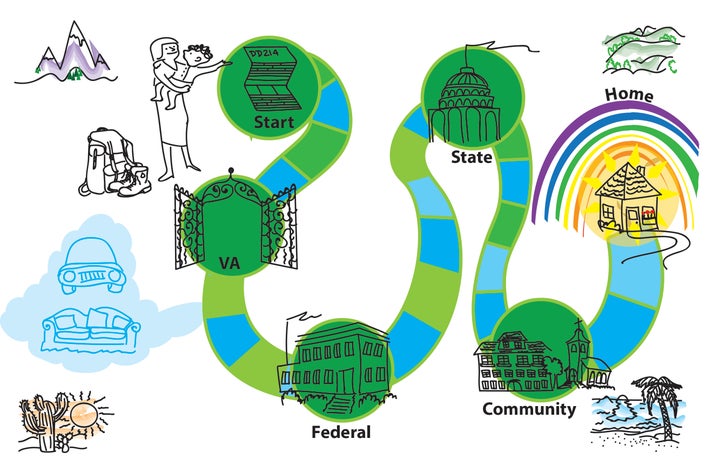
Navigating the “path” from homelessness to housing for women veterans often starts with a visit to VA to establish eligibility.
We’re sitting in Rosie Palfy’s living room, outside of Cleveland, in a house she’s just been able to purchase after VA finally settled her disability claim, after almost nine years of delays and detours. I’m having her read through the almost 400 comments women veterans left in response to my original survey about housing issues after military service, a survey that was completed in 2015 and has since been analyzed. The comments are a striking collection of profound, succinct appraisals as seen through women veterans’ eyes of the challenges they’ve had with precarious housing or homelessness — problems which appear to plague the women veteran’s community, irrespective of their branch, combat era, or even length of time in the military.
Palfy is taking her time to ponder the comments as she reads them aloud, and when she gets to this one, she stops. “This one is pretty profound,” she says. “‘I will always have a fear of not having a safe place to live.’”
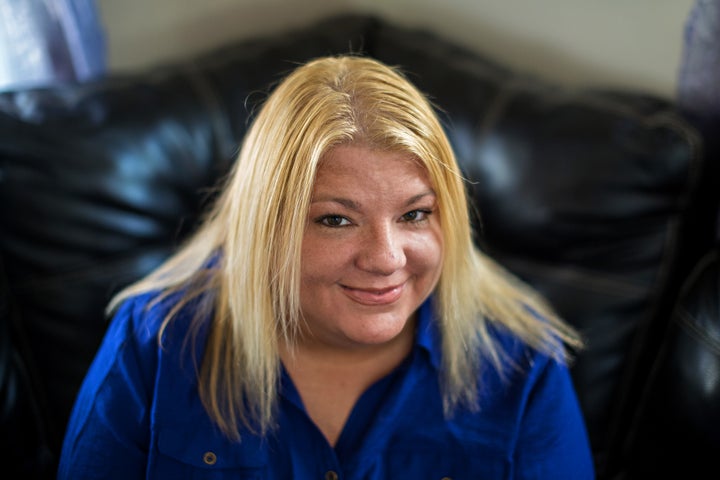
Rosie Palfy, Marine veteran, MST survivor, homelessness advocate, at home outside Cleveland. Photo by Scott Shaw.
Eight-and-a-half years after her disability compensation claim was first filed with VA, Rosie Palfy has found her own safe place to live. In June, she bought a small ranch house in her hometown near Cleveland, and is rejoining life as a Military Sexual Trauma (”MST”) survivor, and all-around veterans advocate. In August, she spoke outside the Republican National Convention on women veterans and homelessness — even got her own heckler, who she managed to settle down. In January, she marched in the Women’s March in Cleveland, carrying a homemade sign that stated simply, “Women Veterans Matter.”
It’s been a long road from an emergency shelter, through transitional housing, to permanent housing for Palfy. She had to learn to navigate a system that she says she didn’t even know existed until she became homeless. And it’s fair to say she’s succeeded admirably, even being featured in a HUD-VASH training DVD for internal use at the Cleveland VA.
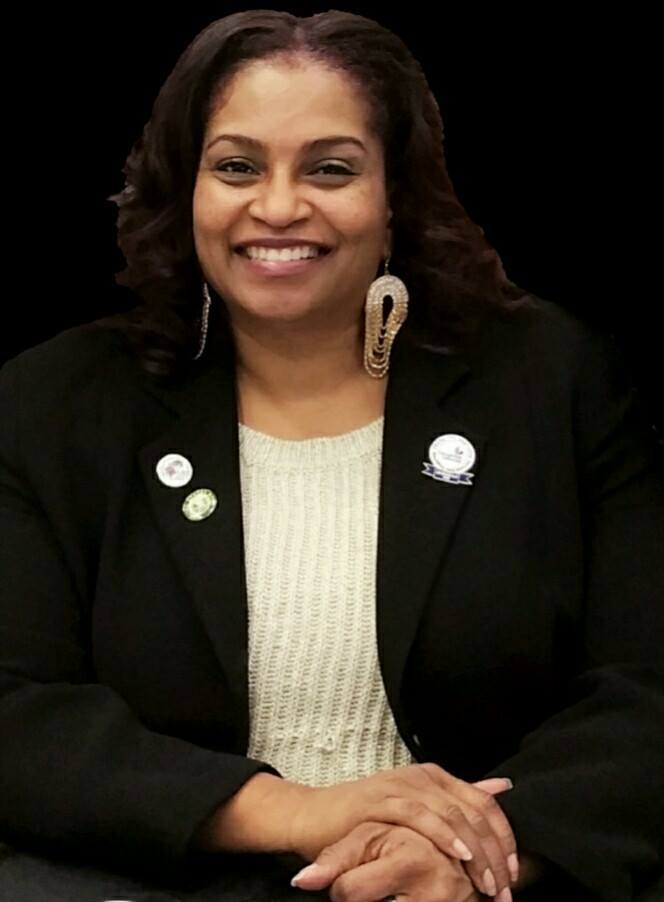
BriGette McCoy, Army veteran, veterans advocate, MST survivor, formerly homeless, social entrepreneur, founder of Women Veteran Social Justice Network.
Palfy is maybe unusually successful for women veterans who have struggled with homelessness, but like fellow MST survivor BriGette McCoy, she’s the new face of how to endure adversity, locate and lean on resources, focus outward on advocacy, and increasingly learn to thrive. (All is not completely ‘rosy,’ though — both Palfy and McCoy continue to endure health issues brought on by their time in the service, as do many other women veterans, and especially homeless women veterans.)
“Do women veterans who become homeless have any warning that they’re about to become homeless?”
When we surveyed people recently about what they most wanted to know about female veteran homelessness, that was one of the top 20 questions, collected here.
Robin Keene wrote her Ph.D. thesis in nursing on “The Meaning of Homelessness for Homeless Women Veterans.” Her work involved interviewing six women veterans who were already part of the VA system in Central Texas for about an hour apiece. And when she asked them to talk about their experiences of homelessness, significantly, each of them described it in similar terms. For these six women veterans, homelessness was very ‘unexpected,’ ‘unanticipated,’ and therefore ‘something (they) were unprepared for.’ Since it was ‘unexpected,’ it was also not something they had developed a plan for. (You can see comments from almost 400 women veterans about housing issues after military service, here.) While Keene’s study involved very few people, her conclusion was consistent with other literature:
“Vulnerable (women) veterans typically do not come to the attention of homelessness services until their homelessness becomes imminent.”
If you’ve been following along in our series on women veterans and homelessness, this may be new material. “Surprised” by homelessness? This is a way that women veterans diverge from their civilian female counterparts. Over and over in the literature — and in anecdotes from advocates in the veterans and homelessness community — you hear stories about how late in the game women veterans wait to ask for help. “Late” like the day that the eviction is happening. So the question arises, what makes women veterans so different in this regard?
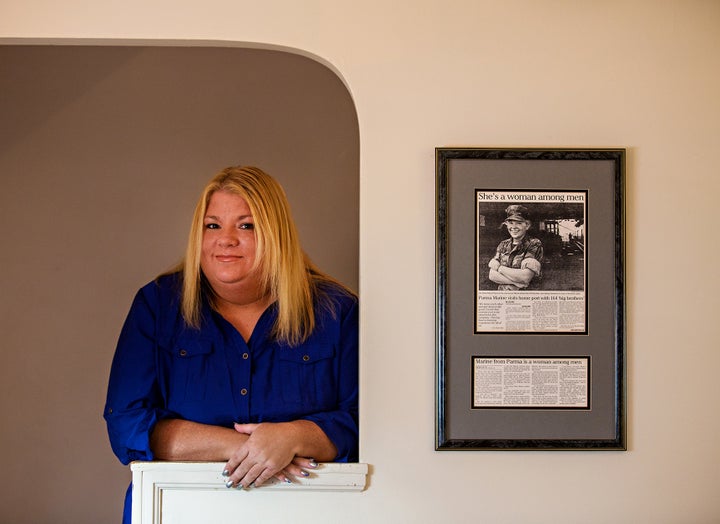
Rosie Palfy stands in an alcove in her old home next to a framed article from the Plain Dealer (Cleveland) in 1993 about her time in the Marine Corps. “She’s a woman among men,” reads the headline about Palfy, who served during the Gulf War. Today, she’s an MST survivor, a homelessness advocate, and almost nine years after first filing her disability compensation claim with VA, she owns her own home. Photo by Scott Shaw.
To answer that, we need to provide a bit of context.
As we have noted in previous articles in this series, the total body of research literature into female veteran homelessness has been extremely slim. Five years ago, there were two studies total identified in the research literature. Then, for a while, one of the “significant” studies VA relied upon to understand this population was what amounted to a focus group of 33 women veterans, all black, all with chronic mental health issues, all living in a shelter in New Jersey. I think we can infer pretty quickly why leaning too heavily on conclusions from this population would lead to skewed impressions. Not all women veterans who struggle with homelessness are black, experience mental health issues, live in shelters, or reside in New Jersey.
Years later, VA came up with ostensibly a better — or at least a more representative — solution, something called “The Universal Screener.” Every veteran, male and female, who used VA healthcare services over a certain period of time and who wasn’t already using VA’s homelessness services was asked the same two questions: Looking back over the past two months, could they report that they had experienced homelessness during that time? And looking forward, over the next two months, could they predict that they would be without permanent housing?
The results were...interesting. Essentially, VA could see that women veterans had a higher than expected representation in the survey, but they had a hard time deciding what to attribute this raised participation to. The mystifying conclusion?
Specifically, future work will focus on to show demographic characteristics such as race, ethnicity, gender, and medical and behavioral health diagnoses and the implications for effective targeting of homelessness prevention resources.
What’s disappointing is what’s missing from that list on where future research should focus: Trauma. Time and time again, we’ve seen, whether in the top-level anthropological and sociological literature on homelessness, the research literature or from the women veterans’ stories themselves, the shadow cast by trauma on female veteran homelessness.
“Trauma-informed care,” housing, even outreach are all pressing needs for this unique population. As one researcher writes:
“As a vulnerable subpopulation of the homeless, women veterans present with different needs from men regarding privacy, gender-related care, treatment for physical and sexual trauma, housing support, and care for dependent children.”
And from the same researcher, elsewhere:
“It is important to understand the characteristics and needs of homeless female veterans and how they differ from those of homeless male veterans to facilitate planning for effective patient-centered services. For example, homeless female veterans are more likely to have children with them, face more problems finding family housing, and are less likely to be employed than men. . . . Also a much higher rate of military sexual trauma has been found among homeless women than men.”
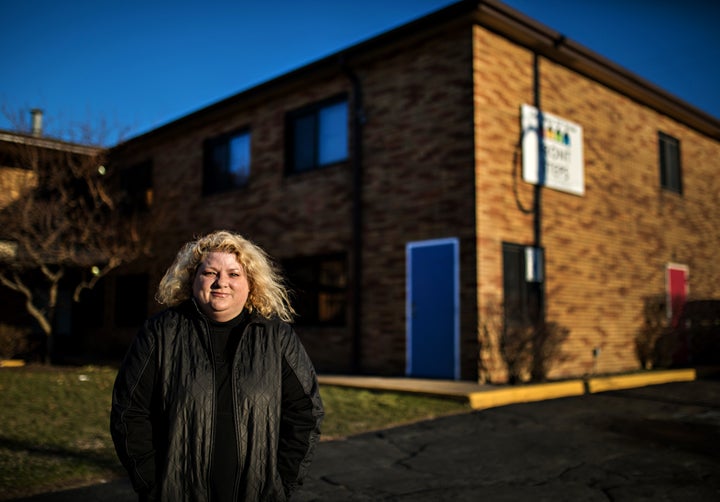
Rosie Palfy, Marine veteran, MST survivor, homelessness advocate, outside her old transitional housing provider, Front Steps, in Cleveland. The building is a converted Travelodge. Palfy has since exited homelessness successfully. Photo by Scott Shaw.
Now let’s go back to the implications of Robin Keene’s work for this population. If women veterans experience homelessness as a surprise — then they’re not likely to be able to anticipate it very easily or well. And ability to accurate predict or assess future risk is at the core of what the Universal Screener is testing. I would argue that only a person who has received an eviction notice — and looked around their kin network and realized they have no options for “cadging a berth on a friend’s couch or living room floor” (in the words of longtime homelessness researcher Kim Hopper, Ph.D.) — would be fully able to anticipate or predict their own homelessness within the next two months.
This isn’t the only place where VA’s methodology falls down. (And to be clear, VA does many things right.) One researcher, writing in 2015, made it plain that VA doesn’t even have a single code for describing homelessness among those who do use the VA system for healthcare, who are after all a subset of all veterans.
“Creating an official VA case definition for homelessness ... would likely allow improved identification of homeless and at-risk veterans.”
Instead, they have at least three codes, with no continuity among them, and the researcher argued that creating a single “V60” code would have the effect of consolidating figures about an even-larger-than-expected population of homeless veterans, including women. In the absence of that, from the same study, researchers allege,
“A related issue is that if (V60 codes) are not being used in a systematic or standardized way in the VA, this would have implications for arriving at accurate estimates of the prevalence of homelessness among veterans.”
We’ve already discussed how unlikely it is that the current counting methodology — the every-other-year Point-in-Time count (estimate) of unsheltered homeless, combined with a full-year count of those using services geared to the homeless such as shelters — can provide anything like an accurate picture of how many homeless women veterans there are.
We have established that women veterans, because of extensive trauma histories, including military sexual trauma, and their status frequently as single mothers with dependent children in tow, makes them unlikely to sleep outside or stay in shelters. For these reasons, they are unlikely to be represented in the count.
We have also taken a look at original research, conducted with a broad spectrum of women veterans from every era, and determined that women veterans are likely to avoid these accommodations in favor of the top three, which are gender-specific: couch-surfing, staying in unsafe relationships (those characterized by domestic violence or intimate partner violence) and sleeping in their cars. Those were the results of our study of 400 women veterans, conducted in 2015. A subsequent study, which is still open, has found similar results in terms of those being the most prevalent choices for women veterans attempting to manage periods of unstable or precarious housing.
We’ve talked about how women veterans, unlike their male counterparts, rely heavily on something called “the kin network” (a concept borrowed from anthropology) which women veterans can pay into, establish credits within, and then withdraw those credits as needed. As Hopper describes, women sometimes “bank” these credits for a future time. The description of use of the kin network is consistent across all the major literature on female homelessness.
“A lengthy sojourn with family immediately precedes the homelessness of women far more often than it does with men.”
Why this matters is two-fold. One, there are a number of terms that describe types of homelessness among individuals, and more to our point, veterans. Homelessness can be “chronic,” “literal,” “episodic,” or “functional,” to name only a few of the terms in use. Second, and perhaps more importantly, when policy hones in on “eliminating” or “eradicating” homelessness, specifically veteran homelessness, it tends to focus on only that form of homelessness which is most easily seen. In other words, “chronic homelessness.”
The chronically homeless, it might not surprise you to learn, are those most likely to suffer from long-term serious mental health issues, unemployment, and drug or alcohol abuse.
Cities which have made inroads into “eliminating homelessness” — and there are a few who have succeeded in this — do this by targeting their most visible homeless, the chronically homeless, and by using an intelligent system of essentially reducing the names, descriptions and whereabouts of these homeless to a spreadsheet, which can be “worked” by caseworkers in the system. This way, they can keep literal track of Bob, a former Marine, who has diabetes, schizophrenia and long-term alcohol abuse, and lives under the freeway near such-and-such intersection. Eventually they can get Bob — or his chronically homeless female counterpart, Bobbi — into some form of shelter. It’s not to dismiss or minimize the impressive inroads such interventions have made in cities across the U.S., but I think by now you can tell what the problem is when it comes to female veterans. Since they tend to stay off the grid and out of sight, they’re not likely to benefit from or even be reached by these interventions.
What we don’t know
A different question we need to be able to answer is how would we characterize women veterans’ experience of homelessness, and how it’s different from male veteran homelessness. We’ve already talked about the need to reboot our stereotype of the homeless veteran, embracing a more updated view that includes female veterans, including single mothers with children. When we think about the old stereotype of homeless veterans, we think of people really down and out who stay that way for years at a time. Again, those are the chronically homeless.
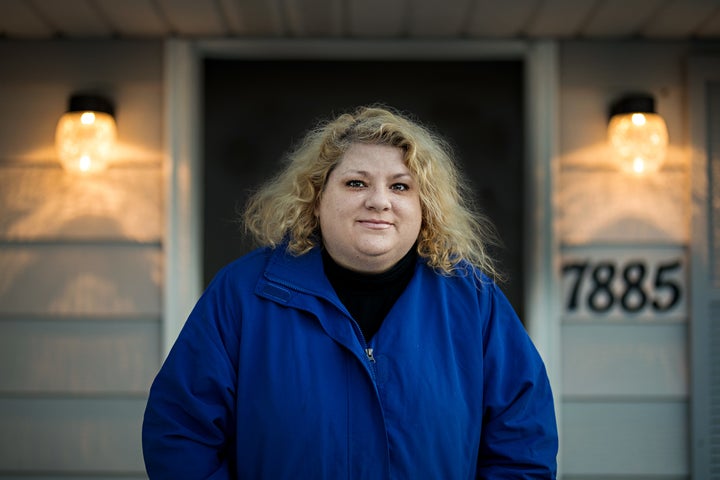
Rosie Palfy, Marine veteran, MST survivor, homelessness advocate, on her new “front steps” — of her own home outside Cleveland. Palfy was able to purchase her home once VA settled her disability compensation claim which had lingered in the system for eight and a half years, for injuries received (and recorded) during her service. Photo by Scott Shaw.
But for women veterans — and women in general — especially because of their ability to rely upon the extended kin network — their experience of homelessness tends to be episodic, not chronic. Eminent sociologist Ellliot Liebow, who published “Tell Them Who I Am: Portraits of Homeless Women” in 1993, wrote about the episodic nature of the homelessness experienced by the women he profiled, referring to it as what amounted to a “revolving door.”
We can’t expect that the Point-in-Time count will identify homeless women veterans, nor counts of who uses a shelter in a year — and we further can’t expect that the Universal Screener VA uses, despite its good intentions, can accurately pinpoint women veterans at risk for homelessness, because it relies on their ability to do what they apparently cannot, which is to predict their own risk.
If homelessness for women veterans is a revolving door, primarily episodic, preceded by lengthy sojourns with friends and family, and reliance on the kin network — if becoming homeless is experienced as a “surprise” to women veterans — clearly there’s a lot more work we need to do to understand their experience, especially in how it differs from male veterans who become homeless, and to update the model through which we respond to their needs. “It’s not that we have more needs or fewer needs than male veterans,” says Rosie Palfy, the former Marine, ruefully. “It’s just that our needs are different.”
(Paradoxically, and this deserves further treatment elsewhere as well as a closer look by researchers, women veterans’ own self-reliance, survivor instincts and “Army of One” can-do attitude may work against them when it comes to appraising their own risk for homelessness correctly.)
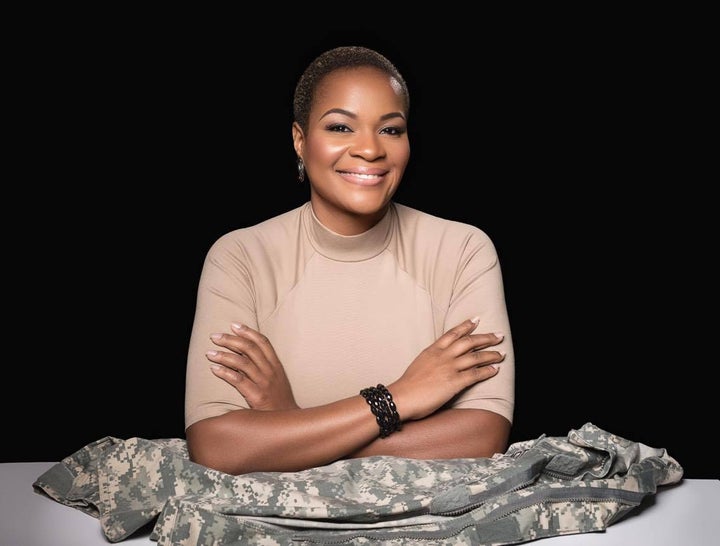
Army Reserve Maj. Jas Boothe, founder of Final Salute, Inc., a program of transitional housing for female veterans in Washington, DC. Boothe is also the creator of the Ms. Veteran America competition, which serves as a fundraiser for Final Salute.
The big picture, though, is something women veterans can find frustrating. There’s talk of invisibility. And, pointedly, “How is that we are still an afterthought in this day and age?” asks Army Reserve Maj. Jas Boothe.
There is a whole history, not just in veteran homelessness, but in homelessness in general where women were simply not seen or understood as having different needs.
In the 1970s, documentary photographer Ann Marie Rousseau spent about 10 years documenting, and then working with, homeless women who lived on the streets in New York City. They were called “Bag Ladies” — a new phrasing at the time to indicate how they seemed to carry all their possessions around with them in shopping bags. She went from photographing them to teaching them photography to writing a book about what she’d learned, called “Shopping Bag Ladies: Homeless Women Speak about Their Lives.” Her book became a made-for-TV movie, starring Lucille Ball, who bought the rights to the story. Interviewed 15 years later, Rousseau said, “When I first worked on my book in the 1970’s there was very little interest in the subject of homelessness, and particularly little understanding of what was happening for women.” Furthermore, she said that she began her project — see how much this description resonates with female veteran homelessness today — “to explore some of the reasons why women became homeless and to document the conditions in which they attempted to survive,” because she found that “women tended to be much more invisible and less identifiably homeless than men,” and she felt they were also in greater danger, with less access to far fewer services.
No safety net/It starts with a myth
Part of the difficulty navigating the complex maze of limited housing resources for at-risk women veterans starts with the myth of there being a safety net in the first place.
“There’s a misconception when you get out of the military that the government will take care of you,” says Palfy. “We can be kind of naive about that.” “You wouldn’t believe how many people think we get a check every month just because we served in the military,” agrees Rebecca Fothergill-Murch, in Seattle.
“Transitioning out of the military, veterans have no sense what’s really waiting for them,” says Amber, the M.P. we met in Part III of our series. “People think that the VA will take care of you,” says Army Reserve Maj. Jas Boothe in Washington, DC., the go-getter from Part II. The flurry of yellow ribbon patriotism — pleasing but superficial gestures of goodwill — gives many service members “a sense of security that (the country) will be there for them in their time of need,” says Boothe. “You don’t find out until the last minute that the handshake has gone away.”

Kristine Stanley, Air Force veteran, full-time veterans advocate.
“We also ask for help way too late,” says Kristine Stanley, the Air Force retiree and veterans advocate in L.A. we met in Part III, echoing conclusions we’ve heard — and read about — frequently. Backstopping this, coming up with creative solutions to help women veterans navigate successful exits from the military, may take doing what Stanley and others are doing in LA, a band of sisters walking one another to needed services. That’s not an uncommon vision, say advocates. “At the end of the day, it’s vets helping vets,” says Texas Veterans Commission’s former outreach director, Edie Disler, the Air Force lieutenant colonel (retired). “It’s always had to be women who’ve brought about change for women,” adds Maj. Boothe.
Boothe, of course, has manifested change in a formidable way. She not only spent $15,000 of her own money to start Final Salute, Inc., a nonprofit that strives to bring attention to female veterans’ need for housing — and runs transitional housing for women veterans in the Washington, DC area — she then created the “Ms. Veteran America” competition to highlight women veterans’ achievements, and uses the proceeds from it to fund Final Salute.
Boothe isn’t the only female service member or veteran who’s decided to take things into her own hands and patch the housing crisis for her sisters by establishing a home for them to live. Homes like this go in and out of business with regularity, and it’s hard to find ones that succeed — although Boothe’s seems like it may, due in no small part to her larger-than-life personality, and rare combination of guts, smarts and focused poise. (You have to see the trailer for “Served Like a Girl,” to get a sense of that. Or watch her on Oprah.)
A handful of homes for women veterans at risk for homelessness, or literally homeless, are sprinkled across the U.S., usually confined to major cities. You can read about them in the news one year, and try calling them the next year only to find out that they’re out of business. Housing options for at-risk, low-income women veterans, including veterans with children, need a lot more than good intentions.
Because of the extensive connection with military sexual trauma, there’s a strong need for these houses to supportive housing, set up along trauma-informed principles. “If it’s not trauma-informed,” says BriGette McCoy, the Army veteran, MST advocate and social entrepreneur in Atlanta, “you’re wasting your time.” Rosie Palfy agrees: “Women veterans are dealing with trauma issues of all kinds.” Safe and supportive housing allows them a chance to unwind in peace and regroup for the next chapter in their lives. Trauma-informed housing will continue to be a need for women veterans and their families, into the future. As the authors of one report, which unfortunately cites wrong statistics on how many women veterans there are, notes:
“…Existing programs needed to be able to accommodate families (not just the veteran) and should offer culturally competent intake procedures and ongoing support in recognition of women’s experiences of trauma, distrust and failure to recognize themselves in the label ‘veteran’.”
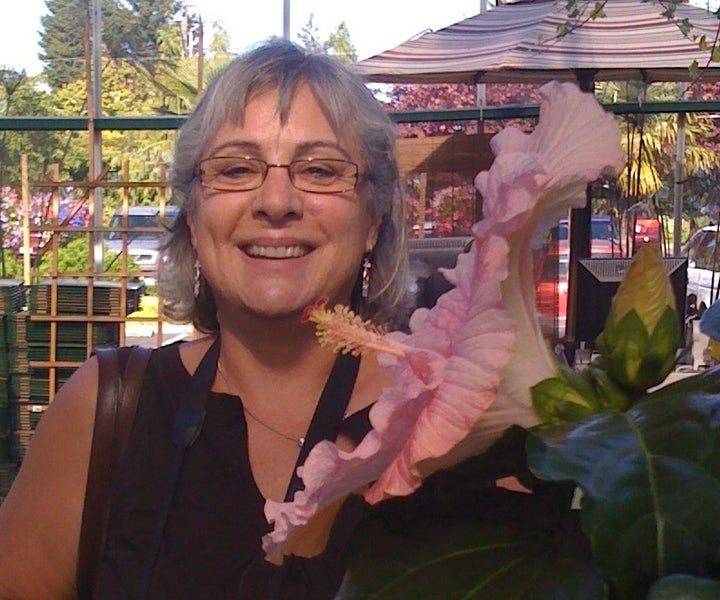
Susan Avila-Smith, Army veteran and Military Sexual Trauma (MST) advocate, founder of VetWow, shown here at Swanson’s Nursery in Seattle.
A separate-but-related issue is transitioning out of the military without adequate financial resources to make the transition successfully. Not everyone who leaves the military does so on their own timetable. Sometimes, service members leave abruptly, due to injury or dismissal. Susan Avila-Smith, the Army veteran and prominent MST advocate we met earlier in the series, suggests that the housing crisis for women veterans could be solved by simply taking $100 out of service members’ paychecks every pay cycle, banking that money for them, and handing it back to them on exiting the military. Having the accumulated small amount of pay set aside could serve as a buffer against hard times.
Because women frequently enter the military right out of high school (one point at which they are similar to their male counterparts), it’s common for them to leave the military without ever having lived on their own, or had to pay rent, buy groceries and pay their bills — experiences civilians are likely to encounter and master to some degree of proficiency from about age 18 on. Because the military envelops service members in something of a protective bubble where those crucial life-skills are concerned, veterans can land in civilian life with a “thud” of unpreparedness. (Yes there are transition classes, but the overall impression is that they’re too short and largely ignored by service members at the time.)
Timetable for struggle
Since almost all the research has been done on male veterans, another important question we’ve sought to answer is how soon after military service do women veterans start to experience unstable housing? (For those who do.) We know from the research literature that the approximate time for male veterans is 10-12 years. This matters for intervention. If women veterans are the same as men, then timing isn’t an issue. If timing is substantially different, however, interventions can’t or shouldn’t wait.

Responses by women veterans about how soon problems with unstable housing began after military service.
In the current, ongoing survey of more than 1,000 women veterans of every era about housing issues after military service, respondents were asked if they experienced problems with unstable housing after leaving the military, and if so, when those problems developed. Although the results of the survey have yet to be analyzed in depth, the findings so far show that for more than half of the women veterans who responded that they had problems with unstable housing, those problems started “immediately” after leaving the military, up until a year afterward.
If those results are sustained in analyzing the data further, they are completely opposed to the historical male model of veteran homelessness, indicating that intervention needs to take much sooner. Maybe Avila-Smith’s idea about setting aside funds from paychecks during service isn’t such a bad idea; but there need to be other ideas as well.
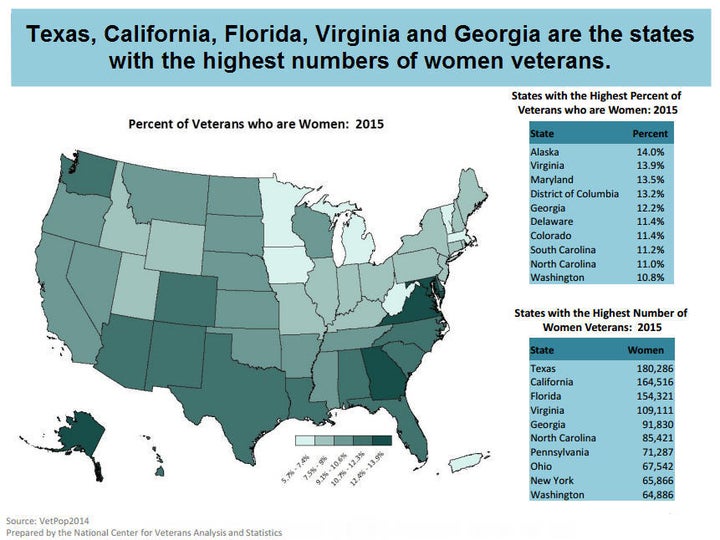
States with the highest percentage of women veterans; and states with the highest numbers of women veterans.
As we wrap up this wide-ranging, comprehensive series on the challenges faced and courage exhibited by women veterans at risk of homelessness reported on under a Howard G. Buffett inaugural grant from the International Women’s Media Foundation, we have a gift to leave with you.
When I first started looking into the topic of gender differences among homeless veterans a little over two years ago, writing about it here, one of the things I wanted to do to satisfy my curiosity about the extent and availability of resources was to get a sense of how many women veterans lived in every U.S. state, and then compare that to the programs that were specifically designed to support them.
VA has multiple housing programs...
Since it’s obvious from reflecting on the literature, anecdotes from women veterans and the results of my own research that accurate numbers of women veterans are unlikely to be established via the usual counting methods, it seems like it’s better to estimate the other way around: How many women veterans there are in each state, how many of them have children, and how many of them — childless or parents — are liable to struggle with unstable housing in any given year?
Final Salute’s Jas Boothe has written a white paper, taking a similar approach — and focusing on the levels of unemployed and underemployed women veterans who have somehow disappeared into the system and are not accounted for. Her supposition is that many of them are struggling with unstable housing.
For my part, I wanted to see how many states had essentially made preparations for accommodating homeless women veterans of any age, with or without children. While VA has several different categories of housing programs — from domiciliaries (shelters) through permanent supportive housing, I was most interested in taking a look at just one of those programs, because it tracks (and reimburses) programs in the community that are designated as accommodating women and women with children (the larger category into which women veterans, with or without children fit).
When I mapped the number of Grant and Per Diem programs against the population of women veterans in the five most populous states for women veterans — California, Florida, Georgia, Texas and Florida — the results were not encouraging. Clearly much more work needs to be done to put a firm foundation under the lives of returning female veterans. (The programs identified do not specifically serve women veterans, although some do — just women and/or their children.)
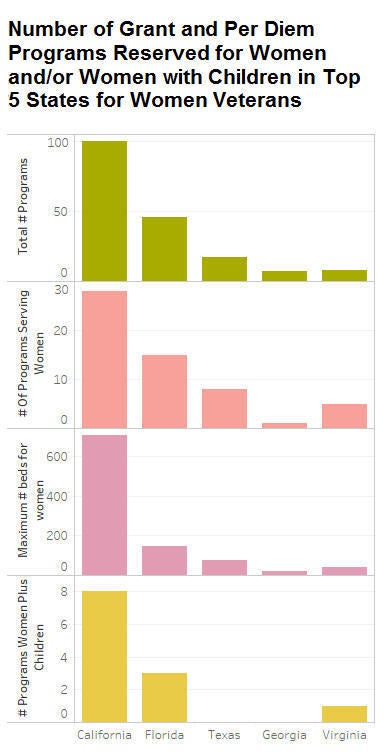
Grant and Per Diem programs designated to serve women and/or women with children in the top five most populous states for women veterans.
Given women veterans’ apparent propensity for being “surprised” by homelessness and consequently a lack of advance planning for crisis, it seemed like the need arose to have a single website with a listing of state-by-state housing resources for women veterans to consult. The IWMF was kind enough to fund the development of this website which is unveiled for the first time here at WomenVeteransHousing.com. (I checked first with VA to see if anything similar was planned, lest we overlap our efforts, and there was not.)
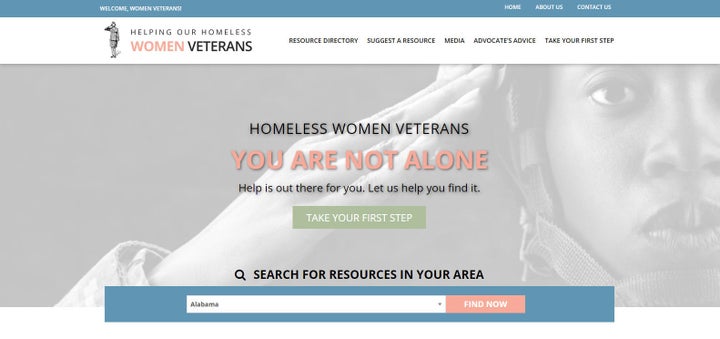
The new website, WomenVeteransHousing.com, offering state-by-state resources for women veterans at risk for homelessness, with the opportunity to crowdsource additional listings.
Women veterans and housing advocates can participate in making this website a success by submitting information about facilities in their communities that offer housing to women veterans, and/or women veterans with children. You can “suggest a resource” here, check the directory for resources listed, or review (and suggest) links to sage advice for navigating the complex system of housing resources.
If you remember the shoe-leather network model Kristine Stanley embodied in Part III of this series — of building a network of women veterans and advocates who knew where the resources were located, as well as the needs of women veterans in their communities, and were physically linking up one with the other — it’s possible this sort of hands-on concern for women veterans at risk of homelessness is what it will take to get them access to the resources they need.
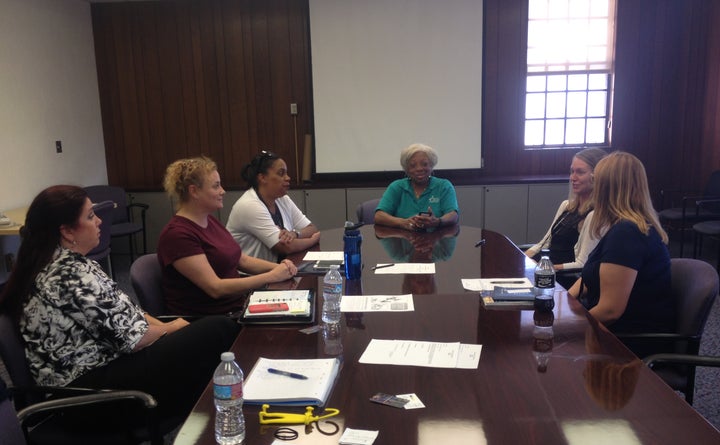
Six women veterans and veterans advocates network during a meeting of the Women Veterans Collaborative in Los Angeles.
Over the course of reporting on this issue, it’s become clear that navigating the system of (already limited) housing resources is a huge barrier to women veterans, with or without children. “Having someone to help you with the process is very helpful,” says Rosie Palfy, who attributes VA case manager social workers for her success.
The two biggest myths, say Palfy, are that “vets are automatically taken care of” — it’s safe to say every veteran we profiled raised that issue — or “that VA is just hopelessly inept.” Instead, she says, VA has lots of great programs that even partner with local nonprofits, but there are criteria veterans need to meet. And there’s no one-size-fits-all approach, she says. Social workers have a sense of which programs suit which veterans best. “Case managers make all the difference,” she says, appreciatively. “Not everyone who wants to, qualifies for a HUD-VASH voucher,” she says, alluding to one of VA’s more popular housing programs. “Veterans who have trouble trusting the system or providers, who don’t follow the advice of their caseworkers, end up getting lost along the way,” says Palfy. The process is very procedural, which many veterans find off-putting. “Sometimes you have to go to a shelter first, to qualify as homeless,” she says, speaking from experience. “There are veterans who think they’re entitled to a housing voucher right away,” she adds,” but they don’t realize there’s a waiting process involved with qualifying for that.” “I think a lot of people are frustrated with the system and want to do it their way,” Palfy says, summing up. “But they need to follow directions.”
Follow the path — start with VA
Turning the maze-like process into a board game-like map, showing a “path to home” for women veterans, was the inspired result of spending a few days in L.A., trailing around with Kristine Stanley and her motivated cohorts. While community resources sometimes exist to house at-risk women veterans, all paths DO lead to VA, at least initially — because veterans can find out by registering with VA whether they qualify for services, and which ones. Establishing eligibility with VA seems to assure that women veterans maximize their options at the beginning of the process — then they can look for state and local or community resources with a better sense of what the possible options are that are available to them.
(VA has a number of housing programs designed for veterans and/or veterans with families, with names like SSVF and HUD-VASH, and you can learn more about these here.)
I don’t mean to paint an overly cheery picture, though, because my — and others’ — sense is that there are not nearly enough resources for the women veterans at risk for homelessness who need them. Not now, and not any time in the forseeable future. And especially not if the count of who’s homeless among women veterans is likely to be off by a significant multiple. Multiple advocates mentioned as well the long wait for housing vouchers, only for veterans to be met by landlords either not understanding how to work with VA or simply not wanting to accept vouchers in a tight housing market. Advocates like Kristine Stanley in LA and Rebecca Fothergill-Murch in Seattle both mentioned their frustration with an emphasis on cities’ focusing on targeting chronic veteran homelessness instead of providing resources that could tide a woman veteran who is precariously housed — say, waiting for her first paycheck to arrive from a new job, without which she and her children are likely to be evicted — and perhaps prevent homelessness entirely.
(And solving this problem will take the effort of major nonprofits with national reach — who can make women veteran homelessness their platform, and succeed in drawing public attention, and dollars, to solving it. Rumor has it that this almost happened a few years ago with the YWCA, whose Henderson House for women veterans and their children in Albuquerque, New Mexico was an early effort. The YWCA, the Salvation Army, Goodwill — national nonprofits with substantial reach — could adopt this population and help smooth their pathway home. They could also partner with VA, who brings substantial knowledge and resources to the table on this, and bring in other partners like USAA or U.S. Vets for their focus and expertise. Groups like the National Association of Social Workers and the American Bar Association could also highlight this issue as part of a national platform advocating change for these women veterans and frequently their children.)
“Chronic homelessness,” which is the type of homelessness most of us picture when we think of the more stereotypical homeless veterans — leaving single women like Palfy and mothers with children like McCoy out of the picture — is also the most visible type of homelessness. Being seen is crucial, writes homelessness expert Hopper, because “it impels advocacy.” But women veterans who are homeless are highly unlikely to be seen, given the choices they make to accommodate periods of unstable housing — choices that continue to leave them off the grid and out of the count.
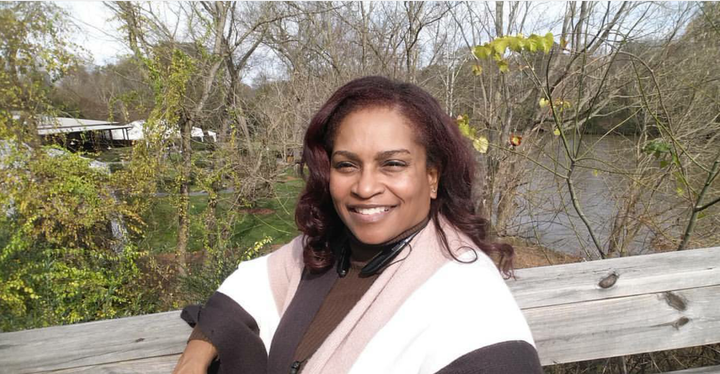
BriGette McCoy, Army veteran, veterans advocate, MST survivor, formerly homeless, social entrepreneur, founder of Women Veteran Social Justice Network.
So the imprecise narrative continues, both in the research literature, which has lagged on the topic of female veteran homelessness, and is belatedly striving to catch up. And it’s lagged in the popular narrative, which has been slow to see that homeless women veterans even exist, and then when they do, has been too ready to attribute their condition to the same old causes that prevail when we insist on “othering,” on seeing anyone with troubles as being fundamentally different from, and weaker than, ourselves. The popular narratives, such as they are, would seem to inspire pity — broken women with broken lives, who maybe were strong once — when they served — but not anymore, when they’re living on Skid Row, desperate, plagued by the usual demons of drugs, alcohol, or chronic mental health issues. Those issues are real, and they do affect a percentage of homeless veterans, both male and female. But the story is much larger than that, more textured, more nuanced.
And it’s not likely to revolve around pity, or patronizing — our natural defenses when we want to distance ourselves from those we don’t understand or assume must be the source of their own troubles. Sympathy says, “I feel sorry for you.” Empathy says, “I’m trying to understand you.” If we’ve learned nothing else from this series, I hope that we’ve come to see how very much women veterans who struggle or have struggled with homelessness are just like us. They deserve our attention, they deserve our best, creative thinking about how to resolve their unique challenges, and they deserve a safe place to sleep.
“Housing is the fundamental need” for women veterans, says Army Reserve Maj. Jas Boothe. “It’s the foundation of stability, and having it starts a positive domino effect.” “Most people take basic housing for granted,” Rosie Palfy agrees. “Just having a key to your own place is priceless.”
NOTE: This article is the final installment in a three-part series, with bonus material, entitled Coming Out of the Shadows: Women Veterans and Homelessness. The reporting for this series was conducted under a Howard G. Buffett inaugural grant from the International Women’s Media Foundation. The first two articles, “G.I. Jane Needs a Place to Sleep” and “Into the Gap: Women Veterans Describe Homelessness,” are linked here and here. The bonus material, “Camaraderie Offsets Trauma for Women Veterans,” is linked here. There are also two additional stories that capture further aspects of the topic: “Homeless Women Veterans Struggle to Be Seen” and “Down for the Count: Women Veterans Likely Underestimated in Federal Homelessness Figures.” There is also an interactive timeline of how we got to this point, a radio show/podcast including Lily Casura, BriGette McCoy and Rosie Palfy talking about female veteran homelessness, and a data visualization showing the comments of 400 women veterans describing their experiences of unstable housing after military service.
Also, if you’re a woman veteran who served in the U.S. military but are not still on active duty, and you’d like to take a short, 5-minute, IRB-approved survey about housing issues after military service, the link to that survey is here while it stays open.
